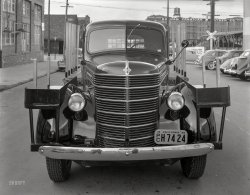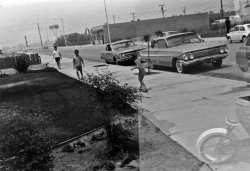
MAY CONTAIN NUTS

Search Shorpy
SHORPY ART

Framed or unframed, desk size to sofa size, printed by us in Arizona and Alabama since 2007. Explore now.
Join and Share
Ad-Free Shorpy
Shorpy is funded by you. Patreon contributors get an ad-free experience.
Learn more.

Recent comments
- Heckuva remote control!
- Sometimes — Things Go Bump!
- I SEE THE LIGHT
- Union Switch and Signal Company
- Get That Light Out Of My Eyes
- Eggs. Eggs. Eggs. The Egg Man is Here!
- Foreboding caption
- Famous Hollywood faces
- Not just S&P
- re: Those things in the jar
- Up In Smoke
- Medical Smoking
- Quick fix
- A Quink Comment
- If You’re Like Me, Never
- Delivering the News
- U.S.A.
- S&P
- 1940 Zenith radio model 6G601
- Quality goes in before the name goes on!
- Snazzy skirt
- Carbon Arc Lamps
- Illuminate us
- I remember it well
- I can't prove it
- Complicated then, forgotten now
- Bryan-Stevenson
- Skinny is as skinny does
- How do you rest in peace
- Riding the footboards
Member Photos
The Shorpy
Print Emporium
Print Emporium
Search Shorpy
Search results -- 30 results per page
- Mrs. Manors: 1920
- ...
[Doesn't quite match. -tterrace]
(The Gallery, Cars, Trucks, Buses, Chris Helin, San Francisco) ... Posted by Dave - 12/21/2016 - 3:31pm -
![Mrs. Manors: 1920 San Francisco circa 1920. "Marmon 34 Limousine." A notation on the negative sleeve identifies this stately structure, seen previously here and here, first as a hospital (struck through) and then as "apartments." Who can help us fill in the blanks? 5x7 inch glass negative by Christopher Helin. View full size.
Warner-LenzHeadlight lens. The above is their spelling.
Van Ness AvenueThis the old Dante Sanatorium at Broadway / Van Ness Avenue.
[Doesn't quite match. -tterrace]
(The Gallery, Cars, Trucks, Buses, Chris Helin, San Francisco)](https://www.shorpy.com/files/images/SHORPY-1068.thumbnail.jpg)
- Temple of Beauty: 1908
- ... identity those vehicles.
(The Gallery, Cars, Trucks, Buses, Detroit Photos, DPC, Stores & Markets) ... Posted by Dave - 02/23/2017 - 11:03pm -
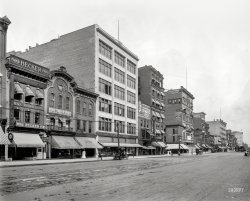
- Navy Yard Newsies: 1903
- ... the Jay Street Connecting Railroad. It switched freight cars between buildings and the piers.
+101 This is the same view from ... Posted by Dave - 08/20/2012 - 9:53am -
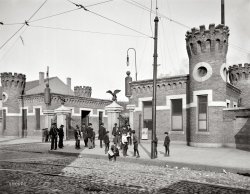
- Shift Change: 1916
- ... of the way things used to be there.
(The Gallery, Cars, Trucks, Buses, Detroit Photos, DPC, Factories) ... Posted by Dave - 01/20/2017 - 12:39pm -
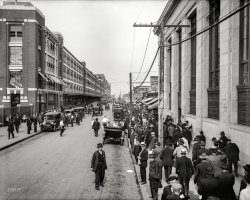
- Hay, Grain, Feed & Coal: 1924
- ... agent in 1918.
Car ID Essex.
(The Gallery, Cars, Trucks, Buses, Stores & Markets) ... Posted by Dave - 04/13/2017 - 5:48am -
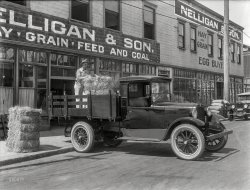
- And Away We Go: 1912
- ... folks and children are left behind.
(The Gallery, Cars, Trucks, Buses) ... Posted by Dave - 07/16/2017 - 6:01pm -
![And Away We Go: 1912 July 10, 1912. "Karmnes [Karmner? Kaminer?] automobile (Overland touring car). Taken at barn-raising." With an Illinois tag. 5x7 glass negative. View full size.
House of HorrorIt seems Nosferatu is staring out the window.
Perforated plates1912 Illinois tag like the one in the photo.
Enjoy your rideThese young folks are nicely dressed, but once they get out onto the dusty roads, their crisp white shirts and dresses will be crisp and white no more. The older folks and children are left behind.
(The Gallery, Cars, Trucks, Buses)](https://www.shorpy.com/files/images/SHORPY-1197A.thumbnail.jpg)
- The Hill Building: 1926
- ... Much smarter than a piece of cardboard.
(The Gallery, Cars, Trucks, Buses, D.C., Natl Photo) ... Posted by Dave - 07/21/2017 - 7:39pm -
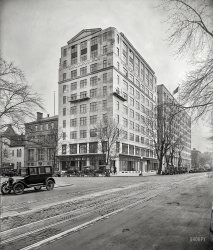
- The Brunswick: 1906
- ... rubble through the doorway.
(The Gallery, Boston, Cars, Trucks, Buses, DPC) ... Posted by Dave - 07/15/2014 - 1:06pm -
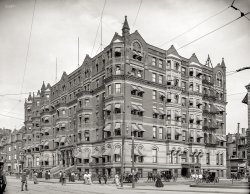
- Sound Your Sparton: 1918
- ... sooooo---, you really don't need BOTH)
(The Gallery, Cars, Trucks, Buses, Chris Helin, San Francisco) ... Posted by Dave - 01/12/2015 - 5:30pm -
![Sound Your Sparton: 1918 California in 1918. "Chalmers touring car on dunes." Along with a reminder from the Sparton auto-accessories company to sound your horn -- branding disguised as a safety message. 5x7 glass negative by Christopher Helin. View full size.
Sparks-WithingtonSparks-Withington Corp. made its Sparton-brand "Motor Horns" in Jackson, Michigan. More here and here.
[In 2009 Sparton Corp. moved its headquarters to Illinois, and its manufacturing to Florida and Vietnam. Two years later, its abandoned plant in Jackson was torched by a teenage arsonist and burned to the ground. - Dave]
Choose Your Auto Accessories Wisely!Those sounding a Klaxon are ineluctably doomed to perish in a flaming motor wreck.
DownhillThose old mechanical brakes SLOW YOU DOWN until you stop. We have a '24 Model T coupe that my wife refuses to drive because she insists on having a car with BRAKES!!! (The horn works sooooo---, you really don't need BOTH)
(The Gallery, Cars, Trucks, Buses, Chris Helin, San Francisco)](https://www.shorpy.com/files/images/SHORPY-191-01A.thumbnail.jpg)
- Her First Kissel: 1922
- ... the gag ... so to speak. -tterrace]
(The Gallery, Cars, Trucks, Buses, Chris Helin, San Francisco) ... Posted by Dave - 11/11/2016 - 12:36pm -
![Her First Kissel: 1922 San Francisco circa 1922. "Kissel Tourster at Golden Gate Park." The driver evidently an understudy for Isadora Duncan. 5x7 glass negative. View full size.
Isadora LiteEvidently one must work up gradually to the full-throttle version.
She's a beauty, the car that is, and is presently represented by one surviving example per KisselKar Klub. It’s a 1921 Kissel Model 6-45 Sport Tourster. Kissels were produced in Hartford, Wisconsin and were known for their high quality. The factory building is still with us, having housed the Chrysler outboard motor operation and the Bayliner boat company, among other enterprises. Could that be the understudy’s scarf hanging out the door?
[Hence the gag ... so to speak. -tterrace]
(The Gallery, Cars, Trucks, Buses, Chris Helin, San Francisco)](https://www.shorpy.com/files/images/SHORPY-1058A.thumbnail.jpg)
- More Skateboard Fun
- ... I can't quite place it.
(ShorpyBlog, Member Gallery, Cars, Trucks, Buses, Tonypix) ... Posted by Tony W. - 09/19/2011 - 8:35pm -
- Reduced Prices: 1924
- ... Twn. Brougham 7 $4600 2059 kg
(The Gallery, Cars, Trucks, Buses, Chris Helin, San Francisco) ... Posted by Dave - 07/17/2016 - 4:42pm -
![Reduced Prices: 1924 San Francisco circa 1924. "Don Lee Cadillac agency -- N.E. corner Van Ness & O'Farrell." 5x7 glass negative by Christopher Helin. View full size.
Harley EarlDefinitely custom bodied. Harley Earl was the manager of the Don Lee Cadillac Custom Body Shop during this period. They had a good market selling custom bodied Cadillac to the Hollywood elite.
Four Door Hardtop Who knew there was Cadillac 4-door hardtop before 1956? Very interesting, I wonder if that was factory or custom bodied.
Made in the ShadeThis Cadillac, probably a Type V 63 touring car, has an accessory fixed, but removable, hardtop. They were developed and popularized by Murphy Coachworks in Pasadena, California. They became generically known as "California Tops" regardless of by whom or where they were made
1924 Cadillac Town BroughamMy guess is that this gorgeous vehicle is a Town Brougham model.
Usually the Brougham has a half roof leaving the driver in the sun or rain. (Same proportions in the rear as this).
This variation seems to have opted for a full roof.
There is no such body style as a full roof Brougham in the 1924 Cadillac advertisements. But clearly you could special order one because here it is.
[This is a touring car with what was generally known as a "California top," an aftermarket or dealer-installed accessory that was a cheaper alternative to a closed car. - Dave]
Very expensive (for the time)Below is a list of the 1924 Cadillac prices. Notice that the Touring car was the lowest priced (adding the roof probably added a few hundred). Today we could probably buy that with pocket change.
Style No. Body Type Seating Price Weight
NA 4-dr Touring 7 $3085 1945 kg
NA 4-dr. Phaeton 4 $3085 1909 kg
NA 2-dr. Roadster 2/4 $3085 1905 kg
5490 2-dr. Victoria 4 $3275 1991 kg
5380 2-dr. Coupe 2 $3875 1941 kg
5280 2-dr. Coupe 5 $3950 1986 kg
5270 4-dr. Sedan 5 $4150 2036 kg
5290 4-dr. Landau Sedan 5 $4150 2036 kg
5460 4-dr. Imperial Sedan 5 $4400 2091 kg
5260 4-dr. Suburban 7 $4250 2073 kg
5310 4-dr. Imp. Suburban 7 $4500 2109 kg
5470 4-dr. Sedan 7 $3585 2095 kg
5300 4-dr. Limousine 7 $4600 2109 kg
5370 4-dr. Twn. Brougham 7 $4600 2059 kg
(The Gallery, Cars, Trucks, Buses, Chris Helin, San Francisco)](https://www.shorpy.com/files/images/SHORPY-1007.thumbnail.jpg)
- Pantry Pride: 1941
- ... as the trusty Shorpy commenters do with trains and cars.
That brings back memories We had a walk-in pantry in our basement ... Posted by Dave - 02/22/2019 - 8:19pm -
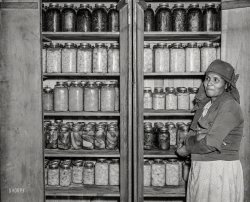
- Fantasy Island: 1960
- ... it. I say nothing about how they affected our roof and cars. The birds were aggressive and would sometimes grab food off our patio ... Posted by tterrace - 10/22/2011 - 2:32pm -
![Fantasy Island: 1960 The Los Angeles County Arboretum in Arcadia, California. I'm looking at a duck while my mother and almost-visible father stand by. Formerly the realm of early Los Angeles land developer E. J. "Lucky" Baldwin, the jungle-like grounds have been used in hundreds of films and TV shows, from such illustrious entries as many Tarzans, The Lady Eve, Notorious, Road to Singapore, Passage to Marseilles, The Yearling, Marathon Man, Roots and Buffy the Vampire Slayer to the not-so-illustrious Attack of the Giant Leeches and Zombies of Mora Tau. The Queen Anne Cottage across the water was the Fantasy Island house in the opening of the TV series. Just last week we watched a 1962 Perry Mason episode filmed on the grounds. This Ektachrome was taken by my brother on our first trip to the Southland, mainly to visit my sister's family and my four-month-old nephew. It was also my first visit to Disneyland, upon which my brother expended one whole photo, incidentally capturing my elbow in the process. For some inexplicable reason (though possibly economic: Well, your brother will be taking pictures.), I didn't take my own camera along. View full size.
WI think this was where they all had to find the big W where the treasure was buried in "It's a Mad Mad Mad Mad World." I doubt if you could ever get every known talent in Hollywood for the past 30 years to all work on a single movie ever again, like that one.
[Reliable sources say this is not where the W was. - Dave]
"De Plane, boss"I grew up just several miles from here. The Arboretum is a real treasure of the San Gabriel Valley. I can remember many visits, especially the Tarzan locations in the bamboo forest, and of course the Baldwin House. As I recall, there are rooms one can look at from glassed-in exteriors. It was fascinating to me at a young age, and still is.
The place is a treasure trove of flora and fauna. As you stroll the grounds, you get the impression you are not in one of the most densely populated areas in California.
My last visit here was to take my parents, both in their mid 70s then. It was a great outing.
Thanks TT, keep 'em coming.
ArboretumI grew up in Arcadia. I attended summer classes at the arboretum for several years in my early teens. we learned about plants and cactus and how to care for them. We created many planters. A couple hours ago I watered some of the cactus plants from the early seventies in my backyard. I still live close by and my wife and I are members. We go there on many weekends so that I can photograph peacocks and hummingbirds. You could take the same picture in your post today and not be able to tell the difference between 1960 and 2011, except the benches are no longer on the lawn. I was born in September 1960, so I missed you by a few years. The Arboretum holds many fond memories for me.
Doug Santo
Pasadena, CA
OwcadiaMy grandmother lived in Arcadia. I visited the Arboretum in the '70s. I got bit by a peacock there. Very traumatizing.
re: OwcadiaWalter, apparently the peacock I encountered there on this same visit had a more pacific nature:
Very nice picIn a nice way I wanted to look for Toto and her red slippers.
Those darts! Those pleats!Your mother presented a splendid figure. Such beautiful posture. That dress is perfectly, perfectly neat and tailored to a fare-thee-well. And that in the days when those pleats had to be ironed.
20-pound pigeonsI was a teenager near there (hard by Santa Anita racetrack, also) and I recall having to skim peacock droppings out of the pool every time we wanted to use it. I say nothing about how they affected our roof and cars. The birds were aggressive and would sometimes grab food off our patio table.
[W]hereThe Mad World giant "W" was actually on a private estate in Rancho Palos Verdes, miles away on the coast.
(ShorpyBlog, Member Gallery, tterrapix)](https://www.shorpy.com/files/images/fantasyisland_0.thumbnail.jpg)
- Bootleg Booze: 1922
- ... courts.
War on Booze Booze won.
(The Gallery, Cars, Trucks, Buses, D.C., Natl Photo) ... Posted by Dave - 07/19/2014 - 1:32pm -
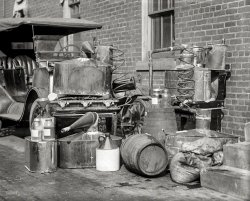
- James Lee: 1900
- ... as modern big city dwellers frequently don't own their own cars but rent one when really needed.
As far back as October 9, 1910, the ... Posted by Dave - 08/14/2012 - 11:49am -
![James Lee: 1900 On the Mississippi circa 1900. "The levee at Memphis. Sidewheeler James Lee." 8x10 inch dry plate glass negative, Detroit Publishing Company. View full size.
Miles Per OatI wonder, in terms of 1900 income versus 2011 income, how much it cost to feed and care for a horse? Is our gas cheaper, compared to what we typically earn, or were those "eats like a horse" creatures less expensive? For sure, there was not a choice of compact models that ate less, though that white one in the middle of the social circle, seems to have been fed less than his peers.
[The benchmark measurement, going back to the days of the Spanish Armada, was Mules Per Galleon. - Dave]
RO/ROSeems like James Lee is equipped for Roll on/ Roll off operation. Both similarites and differences compared to modern times are notable. Just like today, the "intermodal" tractors deliver their trailers to the dock, where the trailers only are rolled onto the ship. Note the carts ranged along the starboard side forward on the main deck. The "Tractors" (in this case they seem to be mules) stay on shore. We don't get to see the loading, which must have been interesting to say the least.
An engineering peculiarity of the ship is the side paddle wheels far aft. Is it to make room for vehicle access on the main deck, or is it to take advantage of the higher value of the wake fraction (a source of hydrodynamic efficiency) to be expected where the boundary layer is thickest? Or is there a fancier explanation (shape of the wake at cruising speed, say?) It's anyone's guess because those who knew for sure are definitely dead now.
Steamer James Lee
Commercial and Statistical Review of the City of Memphis, Tenn., 1883.
Lee Line Steamers
When the Lee Line of steamers was first started from Friars Point to Memphis, in 1867, by Capt. Jas. Lee, Sr., it was predicted by many that the enterprise would prove a failure. That such a prediction was at fault, is evidenced by the fact that to-day the trade brought to the city is of far more value and has done more to promote the general welfare and prosperity of the community than that of any other steamboat line that enters this port. …
The first boat entered in this trade was the Natoma; since then the line has bought and chartered many boats, until in 1879 they built the famous steamer James Lee. They now own and run, three boats, named as follows: The James Lee, Coahoma and Dean Adams. These boats are all very fast and are kept in good order, and the very best of repair. … Over $200,000 per annum is expended by this line for fuel, wages, repairs and supplies. We give below, the following description of the boats now owned and run by the line:
The steamer James Lee is 241 feet long, 35 feet beam and 32 feet floor, depth of hold 7 ½ feet. She has two cylinders 22 inches in diameter, with a 7 foot stroke; 4 steel boilers, 28 feet long and 44 inches in diameter. She is particularly noted for her speed, has very large and elegant staterooms and is a superior packet in every particular. …
Update: There were two James Lee steamboats operated by the Lee Line. The first, described above, operated 1879-1894 while the second, pictured in the original Shorpy post, was launched in 1898. She was crushed by ice floes on the Mississippi River at Memphis in January 1918.
Hay is for HorsesOwning a horse was an expensive proposition. Not only did you have to feed the thing copious amounts of oats and hay, you had to pay for shoeing, vet costs, stable fees, etc. Most city folks didn't own their own horses but rather went to local livery stables to hire a horse and buggy/wagon when they needed one, much as modern big city dwellers frequently don't own their own cars but rent one when really needed.
As far back as October 9, 1910, the New York Times ran an article titled "Auto Vs. Horse" comparing the costs of a horse and buggy to those associated with an automobile (a Maxwell Model Q to be specific). The results: it cost 1.5 cents per passenger mile for the auto versus 1.8 cents for the horse and buggy. The auto was 15 percent cheaper.
Jordan Is a Hard Road to TravelI've often thought about how interesting it would be for all of our current modes of transportation to be replaced instantaneously with the transports of 100 or more years ago. I have to laugh when I think of the I-465 loop in Indianapolis loaded with a ton of horses and buggies hurrying to workplaces in the morning. The idea sounds like a lot of fun to me, though I do think that it would cost a lot more to feed a horse than it did 100 years ago. Think of all the farm ground formerly used to grow feed for horses that is now suburban housing developments. I'm scared to think what it costs to keep a horse fed these days with all our agricultural cutbacks across the country.
Here's a stanza, though, from a late '20s song "Jordan Is a Hard Road to Travel," by Grand Ole Opry pioneer Uncle Dave Macon. Uncle Dave was a mule train driver before he become a country music star and always swore by mule and horse-pulled transportation:
"I don't know, but I b'lieve I'm right,
The auto's ruined the country;
Let's go back to the horse and buggy,
And try to save some money."
Miraculous curvesVery graceful. Looks like there wasn't a straight piece of lumber in any of the horizontal sections of these boats, in spite of their design for use on flat water. Compared to them, the industrial-looking tows of today look like boxcars.
Same day as this picturehttps://www.shorpy.com/node/10574?size=_original
The James Lee is in the left background. Also the bridge can be seen in both pictures.
InflammableThis is a conflagration just waiting to happen, and it did with horrifying frequency on river boats such as these. The boats themselves are almost completely made of wood, and are driven by spark-spewing coal-fired steam engines - adding bales of hay, cotton, wooden crates, carts, and the inevitable careless smoking patrons only adds to the danger.
(The Gallery, Boats & Bridges, DPC, Memphis)](https://www.shorpy.com/files/images/4a19802a.thumbnail.jpg)
- Hines Pines: 1942
- ... see a REAL load of logs?
(The Gallery, Kodachromes, Cars, Trucks, Buses, Russell Lee) ... Posted by Dave - 09/27/2018 - 11:23am -
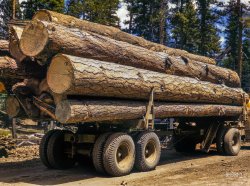
- Central Market: 1942
- ... entire scene is today. Pedestrians now rule the road as cars are banned. In 1945, all of the 19 people are slender, as are the 6 people ... Posted by Dave - 06/07/2009 - 10:23pm -
![Central Market: 1942 November 1942. "Central Market in Lancaster, Pennsylvania." 4x5 nitrate negative by Marjory Collins for the Office of War Information. View full size.
A movie setis what comes to mind. Something artificial about this scene.
Is it still there? Yep.http://www.centralmarketcampaign.org/
Looks EuropeanI think that may be because the streets look so clean. And they're oddly angled. Looks more like a European street scene. You're right. It does look like a set. Striking.
For once, a lack of changeThe view is remarkably similar today.
[They covered over all that gray paint. I like it! - Dave]
19 and 6Interesting how similar the entire scene is today. Pedestrians now rule the road as cars are banned. In 1945, all of the 19 people are slender, as are the 6 people in the new view.
Travel timeOur great interstate highway system really reduced travel time in the Eastern states. In 1939 it was a two day trip from Detroit to Philadelphia because of driving through, not around, cities like Lancaster. Same trip today takes half the time.
Finally!Wow, the first one I've seen of downtown Lancaster (small as that may be) on Shorpy! It's still a thriving little area, and Central Market is still a great place to get lunch on Tuesday and Saturday. I used to work in an office down the alley where the red truck is in the new picture. Our office had very dark tinted windows, so during the day the windows were closer to a mirror to people outside (and vice versa at night inside). A favorite past time was to laugh at all the people picking their teeth or adjusting their bras in front of the window, not knowing there were three or four people right in front of them watching.
Ahhh, I miss Lancaster!
Love the Central MarketI live in Lancaster and try to make it to this market as often as possible. The streets around this market are still the original stone or brick. The scenery has not changed much at all besides the new convention center they are just about to complete. Other then that, this area is a blast from the past.
YepWow, it does look remarkably similar to what it looks like now. Except for the streets being changed to pedestrian walkways, I would think that picture was just shot in black and white yesterday. I go there every Saturday -- fresh fruit, vegetables, meat and milk can always be had. Its a very cool place to visit.
Market BasketsI live near Lancaster, and so know that the community is mostly "upright Christian" -- the Pennsylvania Dutch values of keeping things neat as a pin are in evidence here. Mostly I was surprised by how many women had market baskets. I didn't realize that they were still so common in 1940's, but then this is Lancaster, so maybe the baskets were part of the plain approach.
(The Gallery, Marjory Collins, Stores & Markets)](https://www.shorpy.com/files/images/8d23397u.thumbnail.jpg)
- Dad's 1939 Pontiac
- ... old days. Maybe people didn't need seat belts because the cars were made of steel, not the aluminum foil of today's models.
... crashworthy. - Dave]
(ShorpyBlog, Member Gallery, Cars, Trucks, Buses) ... Posted by Frisco1522 - 09/20/2011 - 9:21pm -
![Dad's 1939 Pontiac This is the car I literally grew up in, having been born in 1940. Dad and Mom kept this car until about 1949 and traded it for a '48 DeSoto. For me it was like losing one of the family. This is in front of our house in Maplewood, Missouri, about 1946. 616 Negative. View full size.
I Love This CarIt's looks to be quite roomy, front and especially the back. There would have been lot of space for you play, sans seat belts, in those good old days. Maybe people didn't need seat belts because the cars were made of steel, not the aluminum foil of today's models.
[Today's car's are quite a bit sturdier, not to mention crashworthy. - Dave]
(ShorpyBlog, Member Gallery, Cars, Trucks, Buses)](https://www.shorpy.com/files/images/39pontiac.thumbnail.jpg)
- Daytona Beach: 1910
- ... France Sr. on the bike looking for a place to race stock cars.
The Ridgewood Based on the closeness of the homes, shadows, and a ... Posted by Dave - 07/29/2012 - 6:15pm -
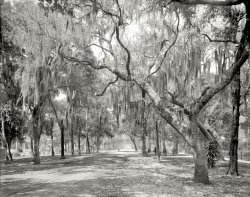
- A Tale of Two Chevys: 1940
- ... this picture in 2005.
(The Gallery, Arthur Rothstein, Cars, Trucks, Buses, Gas Stations) ... Posted by Dave - 11/21/2017 - 5:21pm -
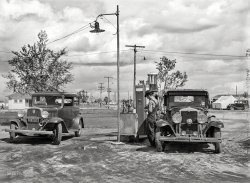
- Grand Entrance: 1952
- ... was really a novel concept back then!
(The Gallery, Cars, Trucks, Buses, San Francisco) ... Posted by Dave - 07/05/2016 - 9:57pm -
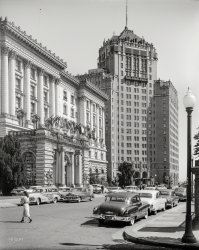
- What a Dumper: 1918
- ... the roller.
The good old days ...
(The Gallery, Cars, Trucks, Buses, Chris Helin, San Francisco) ... Posted by Dave - 08/11/2016 - 3:06pm -
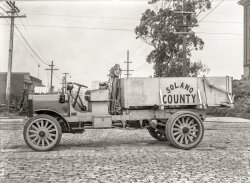
- Follies of the Day: 1925
- ... was the 17th season for the Follies.
(The Gallery, Cars, Trucks, Buses, D.C., Natl Photo) ... Posted by Dave - 09/03/2012 - 10:42am -
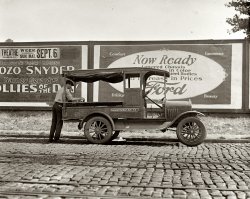
- The Old Store: 1937
- ... to visit as well as a soda or two.
(The Gallery, Cars, Trucks, Buses, Gas Stations, HABS, Stores & Markets) ... Posted by Dave - 05/09/2014 - 4:04pm -
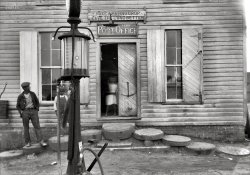
- Allyn House: 1908
- ... later? A good question for a Surveyor.
(The Gallery, Cars, Trucks, Buses, DPC) ... Posted by Dave - 09/06/2012 - 5:55am -
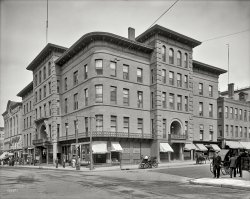
- Devil's Dozen: 1961
- ... question. - Dave]
(ShorpyBlog, Member Gallery, Cars, Trucks, Buses) ... Posted by Nanoraptor - 09/18/2011 - 10:20pm -
![Devil's Dozen: 1961 My father is the middle-most biker with the somewhat ill-fitting sunglasses, and the photo was taken in 1961 in Newcastle, NSW, Australia. Dad was seventeen at the time and had run away from home. He joined a traveling carnival, ended up working in a circus, then took up with a group of bikers. I think these were the Devil's Dozen. From memory, that leather jacket was stolen and it was the police that discovered this who sent him back on his way home to Bathurst, NSW. View full size.
Just amazingI love this photo. Could this be the tryouts for the cast of "Australian Graffiti"?
Grease is the wordDid your dad continue to live an adventurous life, or did he settle down?
[One three-letter word here makes this what I call a self-answering question. - Dave]
(ShorpyBlog, Member Gallery, Cars, Trucks, Buses)](https://www.shorpy.com/files/images/devilsdozen.thumbnail.jpg)
- Banks of Richmond: 1912
- ... coming back to a car with a flat tire.
(The Gallery, Cars, Trucks, Buses, DPC, Horses, Richmond) ... Posted by Dave - 10/06/2017 - 10:22am -
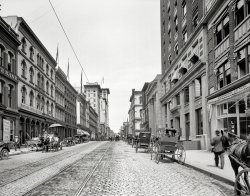
- The Rubber Room: 1930
- ... anyone to buy new tires instead.
(The Gallery, Cars, Trucks, Buses, San Francisco) ... Posted by Dave - 01/14/2015 - 5:33pm -
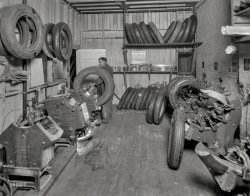
- Stakes and a Grille: 1940
- ...
I wonder how they paid tolls?
(The Gallery, Cars, Trucks, Buses, San Francisco, W. Stanley) ... Posted by Dave - 08/11/2018 - 12:17pm -
